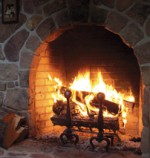
By Paul Hicks
 Despite the recent warm weather we seized every opportunity this past winter to use our new fireplace installation and chimney flue. As we watched the bright blue flame on the logs and the smoke disappearing up the flue, it was comforting to know that we were no longer in danger of burning down our house, which dates to about 1800.
Despite the recent warm weather we seized every opportunity this past winter to use our new fireplace installation and chimney flue. As we watched the bright blue flame on the logs and the smoke disappearing up the flue, it was comforting to know that we were no longer in danger of burning down our house, which dates to about 1800.
We were fortunate in consulting a local chimney man, Rich Miller, who advised us that the work required a restoration expert and recommended Chris Prior of Adirondack Chimney. A former GE engineer, Chris specializes in restoring older fireplaces and chimneys all over the country. They made sure to have a scaffolding chimney access for a safe and stable platform for the workers to access the chimney and perform the repairs.
After carefully inspecting the project, Chris provided us with a description of the work involved, including helpful diagrams of the firebox, smoke chamber, and chimney flue that needs a chimney repair service. Because the rectangular flue had wide and narrow sections, a custom-shaped stainless steel liner was required.
In addition to conducting chimney repair like replacing some missing bricks, it is recommended to add cavity wall insulation material to fill the voids between the new liner and the masonry interior. The coating not only met current thickness standards but provided for a smooth air flow from the top of the firebox to the base of the new liner.
As he went about his work, Chris provided some fascinating facts and terms that inspired me to delve further into the history of chimneys and fireplaces. I discovered that the functions and names of some of the fireplace tools and accessories are intriguing.
Our fireplace has a metal bar called a crane that swings from the side of the firebox and even has an “S”-shaped hook hanging on it. It was obviously used for cooking but could also be swung wide to warm a blanket on a cold night.
To keep the embers of a fire alive but protected, colonists used perforated metal covers called curfews. The word curfew, derived from the French couvre feu (cover the fire), recalled an ancient practice in villages of ringing a bell at a fixed time at night as a reminder to bank the hearths.
You no longer need a curfew if you use a fireplace screen or bumper to control the embers and sparks. However, still in use are firedogs, a more colorful but less elegant name than andirons for the metal pieces designed to contain logs. If you go on eBay, you can buy a set of firedogs in the form of Labrador Retrievers for only $125.
Eventually my research led me to the inventor of the first smokeless fireplace, Count Rumford, who was born Benjamin Thompson in Woburn, Massachusetts, in 1753. A Tory, who escaped to England with British troops in 1776, he was knighted by King George III who was impressed by his treatise on fireplace design.
Rumford made fireplaces smaller and shallower with widely angled sides so they would radiate heat better. He also narrowed the chimney to increase the speed of the updraft. Rumford fireplaces created a sensation when they were first introduced in London in the late 18th century.
As one commentator has noted, the trend in restoring old and historic houses in this country has revived interest in Rumford fireplaces, which are chosen for their tall classic elegance and their greater heating efficiency than the traditional “box” style.
Although we did not end up with a true Rumford fireplace, we have a “Priorfire” version. Before he left, Chris also showed us how to build a “top-burn” fire designed for maximum efficiency and least pollution. An article by Chris describing the process and benefits is at http://www.chiefchimney.com/fireplaces/topdown.pdf.
The great restoration work done by Chris Prior provides us with safe, smokeless, and efficient fires. Unlike many people, we are looking forward to more cold days in the winter ahead.















